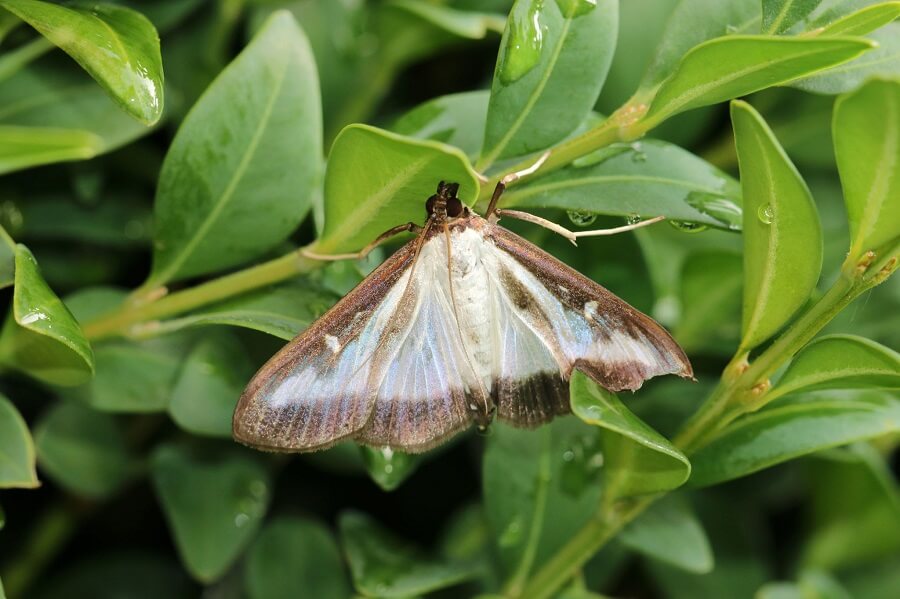The Box Tree Moth (Cydalima perspectalis), native to East Asia, has become a concerning pest in various parts of the world, including southern Ontario, Canada. This invasive species poses a significant threat to the region’s beloved boxwood shrubs and other ornamental plants. With its voracious appetite and rapid reproductive capacity, the Box Tree Moth has the potential to cause extensive damage to the local ecosystem and horticultural industry. This article explores the characteristics, lifecycle, impacts, and management strategies related to the Box Tree Moth invasion in southern Ontario.
This week (June 6) the larvae have been identified in many regions, and large losses of boxwood hedges are already being reported. We encourage you to become familiar with the characteristics and stages of this pest, and monitor your landscapes and gardens frequently for its presence.
Characteristics of the Box Tree Moth: The Box Tree Moth is a small-sized moth with a wingspan of about 4 centimeters. The adult moths have white wings with a brown border and distinctive dark markings. However, it is the larvae that are most damaging. These caterpillars are bright green with black heads, and they can grow up to 4 centimeters in length. The Box Tree Moth larvae are known for their voracious feeding habits, consuming the foliage of boxwood plants, which are widely cultivated in southern Ontario for their aesthetic appeal and structural use in gardens and landscapes.
Life Cycle and Reproduction: The life cycle of the Box Tree Moth consists of four stages: egg, larva, pupa, and adult. Adult female moths lay clusters of up to 100 eggs on the underside of boxwood leaves during the summer months. The eggs hatch within a week, giving rise to the caterpillars that begin feeding on the foliage. The larvae undergo several molts as they grow, consuming increasing amounts of plant material. They spin silk threads to create protective webs, which can engulf entire boxwood shrubs. The caterpillars eventually pupate within these webs, emerging as adult moths after approximately two weeks. The moths are active during the warmer months and can produce multiple generations per year, allowing for a rapid increase in population size.

It is important to note that after a few seasons of Spongy Moth (LD Moth) infestations, learning to distinguish between the two moths is crucial in preventing the spread of Box Tree Moth. Learn to identify the differences here.
Impacts on Ornamental Landscapes: The introduction of the Box Tree Moth to southern Ontario poses a grave threat to the region’s ornamental landscapes. Boxwood shrubs are highly valued for their dense evergreen foliage, ability to be shaped into various forms, and resistance to deer browsing. However, infestations by the Box Tree Moth larvae lead to defoliation, resulting in weakened and disfigured plants that are susceptible to secondary infections and increased mortality. The aesthetic appeal and structural integrity of ornamental gardens, hedges, and topiaries suffer greatly when invaded by this destructive pest.
Management and Control Measures: To mitigate the damage caused by the Box Tree Moth, it is crucial to implement effective management and control measures. Early detection through regular inspection is vital to identify infestations and take prompt action. Cultural practices such as pruning and maintaining plant health can help mitigate the impact of infestations. Manual removal of caterpillars and egg clusters is an effective control method for small-scale or localized infestations. However, chemical insecticides are often necessary for larger-scale control. When using insecticides, it is essential to choose products labeled for the control of caterpillars and follow the instructions carefully.
Furthermore, raising awareness among the general public, horticultural professionals, and nursery operators is vital to prevent the accidental spread of the Box Tree Moth. As growers of boxwood, Connon Nurseries is being diligent in educating their teams and customers about the risk that this pest poses. Collaboration between government agencies, researchers, and the public is essential for implementing integrated pest management strategies, including biological control agents such as parasitic wasps that target the Box Tree Moth.
The Box Tree Moth invasion in southern Ontario poses a significant threat to the region’s ornamental landscapes. Implementing vigilant monitoring, cultural practices, and appropriate control measures can help mitigate the impact of this invasive pest and preserve the beauty of boxwood shrubs and other ornamental plants.




